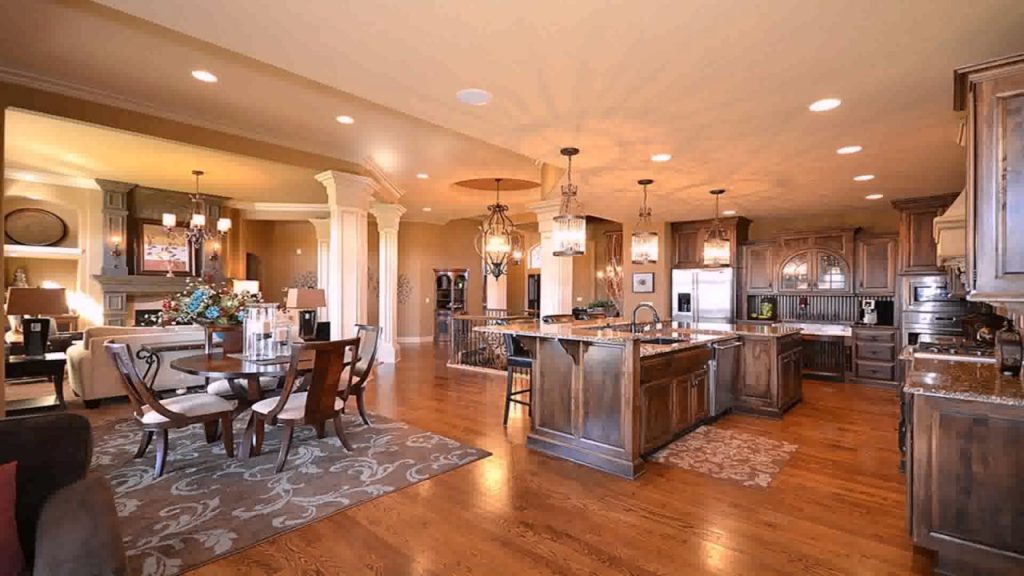Combining Rooms Requires Architectural Design Considerations

|
Ads we feature have been independently selected and reviewed. If you make a purchase using the links included, we may earn commission, which helps support the site.
Open floor plans have been popular since around 1990. They’ve been the center of attention in many comprehensive remodeling projects in older homes. The objective is to join kitchen, dining room, and living room, (or some combination of the three) into a form of communal living space, or as it has come to be known, the “great room.”
Positive Open Floor Points
- Rooms can share lighting such as pendant track lighting fixtures with others, reducing duplication of resources.
- Improves traffic flow between rooms.
- It’s a contemporary style so it protects your home equity. This is key if you ever plan to sell your home.
- It enhances sociability; communication between spaces is made possible (and you can keep an eye on the kids while you’re cooking).
Negative Open Floor Points
- It will potentially cost more to heat and cool. Homes with stand-alone rooms can utilize heating and air conditioning zone control.
- Forget about sound control.
- There is a higher initial cost going it because, hey, no load-bearing walls!
Designing Around the No-Zoning Issue
Ironically, the very thing that gives the open-floor scheme its appeal, openness, can also present its own problem. With no delineation between the kitchen and other areas the space loses character. One way to give the living room its own identity is taking advantage of the furniture. A long sofa is a great way to create a delineation line.
Further, adding an area rug under the sofa and a floor lamp or two beside the sofa will give more definition to the living zone. Standing lamps will also serve to give your living room its own identity.
Resist the Temptation to Incorporate too Many Styles
A certain degree of eclectic design is great, but don’t overdo it. Mismatched furniture and interior decor items will visually over-complicate your open floor space and make it look busy. Choose furniture and accessories that differ in color and material but are still in agreement with one another visually, such as different shades of the same color. Different, yet compatible.
A Focus on Lighting
One common mistake is not carefully planning lighting at the beginning of the project. This is the time to do it! Lighting is not only functional, it also sets the mood in the space. Think carefully regarding your furniture placement. Be sure that your lighting is positioned where it needs to be. As an example, if your sofa is located to be a a delineation line, as mentioned above, an electrical outlet may need to be installed in the floor.
Also, consider the type of lighting technology you want where. Soft, bright, daylight, cool? LED, halogen, or fluorescent lighting? The types of fixtures can vary in the different rooms. One fixture I have is an LED light fixture that features three adjustable wings. Each wing can be adjusted which makes it very versatile. In some situations it is the ideal solution.
Make Your Kitchen Conform
One mistake that is often made is styling the kitchen separately for the other areas. Your kitchen should be considered an integral part of the architecture of your home and the style of your living area. When you are choosing elements for your kitchen like colors, cabinet styles, countertop, and backsplash materials be sure that they conform to the design era of your home as a whole as well as the decor you add to the adjoining spaces. For example, something as simple as repeating the same “family” of colors and finishes in your kitchen and living spaces will infuse a sense of cohesion aligning the two areas.
Residential open floor plan design is not difficult when you keep these concepts in mind. With new construction and a solid concept, it’s easy to do everything right the first time. When remodeling a home that currently has the separate-room concept, things get a bit trickier because special consideration must be given to removing load-bearing walls. And when buying a home that’s already open floor, you’ll want to make it your own stylistically, so keep these principles in mind.
Further Reading
- Finding and Evaluating Contractor Bids for Remodel Projects
- Contemporary Pendant Track Lighting
- Five Easy Fixes to Increase Your Home’s Value
- Heater and Air Conditioner Zone Control
- Balance a Room with Faux Windows
- Use a Feng Shui Compass Reading in Home Design
- Emerging Architectural Design Styles
Looking for more great content? Visit our main page or partner sites:
I offer article and blog-writing services. Interested? Hire Me!
Did you find this article helpful? Millions of readers rely on information on this blog and our main site to stay informed and find meaningful solutions. Please chip in as little as $3 to keep this site free for all.




